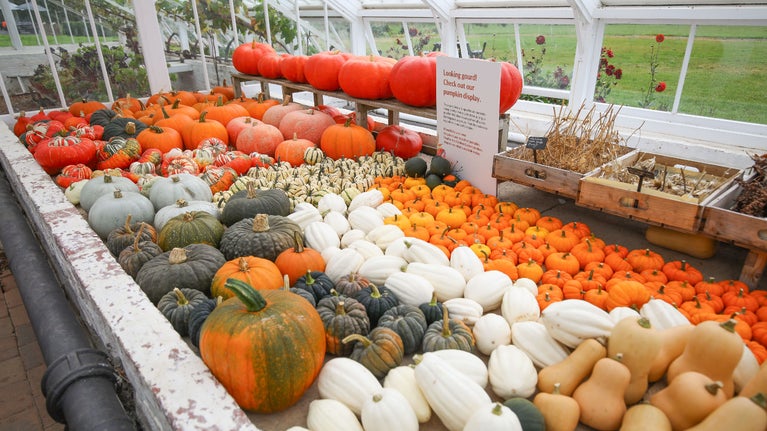Cold, wet year and thriving slugs bring disappointment to the pumpkin patch as Halloween approaches
- Published:
- 08 October 2024

Cold, wet weather and a boom in slug populations have led to disappointing pumpkin harvests at a number of National Trust gardens, as many gear up for autumn and Halloween celebrations.
One of the worst affected was Kingston Lacy in Dorset, where pumpkins and squashes had to be harvested a month earlier than usual, marking the earliest ever harvest for the property. Only half of the garden’s normal crop was saved.
Andrew Hunt, Head Gardener at Kingston Lacy, said: “Pumpkins need a long, hot growing season to do well. Unfortunately, we had a cold and prolonged spring, which meant that germination took place later than normal and then the cooler and wetter conditions over the summer really haven’t helped.”
All might have been saved by a dry sunny start to autumn but in fact the wet and cold September meant plants stopped growing and needed harvesting early.
Arlington Court in Devon also reported an ‘abysmal’ season for squashes and pumpkins, with poor weather and slugs causing the loss of more than 150 squash and pumpkin plants.
Buckland Abbey, also in Devon, harvested its pumpkins last week, having started to lose fruit to the molluscs.
Sam Brown, Head Gardener, said: “Slugs are a big problem this year. The only method I found that really worked was coming out in the evening and picking them off for the first few days after planting out.”
The growing challenges weren’t restricted to the south-west.
Dunham Massey near Manchester would usually produce 30-40 pumpkins for an autumn display but this year there are none – all of the plants were eaten by slugs when young. And Nostell, in West Yorkshire, typically produces around 80 pumpkins and squash but this autumn has just 25.
Paul Dibb, Garden & Outdoors Manager at Nostell, said: “The wet spring and early summer has resulted in an army of slugs attacking the young plants we grew and planted out. It’s been a struggle to get any established in time to produce fruit.”
Many gardens, like Tyntesfield near Bristol and Calke Abbey in Derbyshire, reported a slow start to the pumpkin growing season because of the cold and wet weather, but managed to catch up.
Heloise Brooke, Calke Head Gardener said: “The pumpkins took much longer to get going and we had to resow some due to slug damage, but they caught up well. We still got some great pumpkins and gourds, which we’ll display on our pumpkin ‘theatre’, but there definitely won’t be as many as previous years.”
Sissinghurst Castle Garden in Kent had a slightly reduced pumpkin crop this year in its 2-acre organic vegetable garden, but vegetable gardener Olivia Steed-Mundin thinks the culprit was noticeably low populations of bumblebees – an important pollinator – this year. The cold wet start to summer reduced the number of pollinating insects needed to fertilise flowers.
Slugs and snails were less of a problem at Sissinghurst and the team are putting this down partly to new habitats created to attract beneficial wildlife, including a pond to encourage slug-eating amphibians and ‘beetle banks’ to shelter ground beetles which eat slug eggs before they have a chance to hatch.
Rebecca Bevan, plant health and sustainability consultant at the National Trust, and author of The National Trust School of Gardening, says 2024 was a challenging growing season for most vegetable gardeners.
Rebecca added: “But the rain was great for many garden plants, meaning they experienced no drought stress. Don’t be put off – every year is different and next autumn could be great for pumpkins.”
Panel information:
Slugging it out: How to give your pumpkins the best chance
- Many creatures including slow worms, frogs and toads feed on slugs, so encouraging these in your garden can help control slug numbers.
- Always harden off young veg plants before planting.
- Plant your pumpkins out when warm, dry weather is forecast if possible to give them the best start.
- Keep an eye on newly planted plants, as this is when they are most vulnerable.
- Try cloches to protect newly planted plants.
- Check plants and under pots on warm, damp evenings and remove any slugs and snails you find. Beer traps can tempt them away from precious plants.
- Placing copper tape around pots, and using a mulch of gravel, wood shavings or sharp sand can help keep slugs and snails away.
- Grow your veg in raised beds and keep grass cut short around them. Avoid having hiding places for slugs and snails nearby.
- Grow plants which slugs don’t like, such as endive and broad beans.
- Some gardeners use slug pellets – fortunately for nature the ones containing metaldehyde are now banned. If you use the ferric phosphate ones, scatter thinly, preferably keeping areas covered with cloches or netting in case birds pick them up.
Edited extract from The National Trust School of Gardening, by Rebecca Bevan